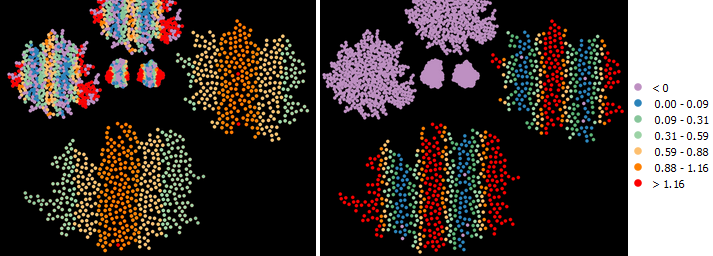Many user-generated datasets (e.g., social media) reflect a number of different phenomena. Consequently, these datasets also comprise very different spatial scales. It goes without saying that this evokes tremendous challenges when conducting spatial statistical analyses of such datasets. When assessing spatial autocorrelation among the observations, for example, classical approaches are usually not appropriate. These were defined for other kinds of datasets that typically just reflect one specific phenomenon.
Ongoing research in our group is eager to enhance spatial statistical analysis of these modern kinds of datasets (see, e.g., here). Thus, we are proud to provide you some insight into our latest ongoing research on that issue. Below you see two figures that are roughly showing the strength of spatial autocorrelation within an artificial dataset. The observations in the different clusters interact at different spatial scales and thus simulate different spatial phenomena. In our first tests we adjusted the analysis scale to the scale of the largest clusters. As the figure at the left-hand side indicates, the classical local Moran’s I index (the quasi standard approach) is not able to properly deal with the issue of having different phenomena in the dataset. Note how it accentuates the smaller clusters. In contrast, a new kind of spatial autocorrelation measure that is currently being developed in our group is well-suited for capturing the true spatial structure of the regions (figure at right-hand side). More coming soon! Stay tuned!
cmp:
Westerholt, R., Resch, B., and Zipf, A. (2014): A local scale-sensitive indicator of spatial autocorrelation for assessing high- and low-value clusters in multi-scale datasets. International Journal of Geographical Information Science, issue pending, pp. pending. DOI:10.1080/13658816.2014.1002499.



